Unfortunately, so many well-made plans are hampered by uncooperative weather! Although last week’s attempt to kayak the more than 10 mile round-trip to the Dome Houses on Cape Romano was abandoned, I still decided to research their story. After all, the trip is only postponed!
Most people, including many Floridians, have not heard of the Dome Houses which makes them an ideal ‘off the beaten track’ excursion in South-West Florida. Here is the story of the Dome Houses, as well as the account of an afternoon’s paddling at close-by Tigertail Park on Marco Island – a true kayaker’s paradise!
The Dome Houses At Cape Romano
The Dome Houses are located just 5 miles south of Marco Island, on a little barrier island in the Ten Thousand Islands and Rookery Bay Preserve area close to Morgan Island and Cape Romano Island (on southern tip).
These strange – almost alien – looking structures are what is left behind from Bob Lee’s ‘Dome Houses’, perfectly inhabitable vacation homes built in the 1980’s by the retired oil magnate. Bob Lee’s Dome Houses were quite ahead of their time and in some ways ahead of even our time, as they were designed to be totally self-sustaining and solar powered!
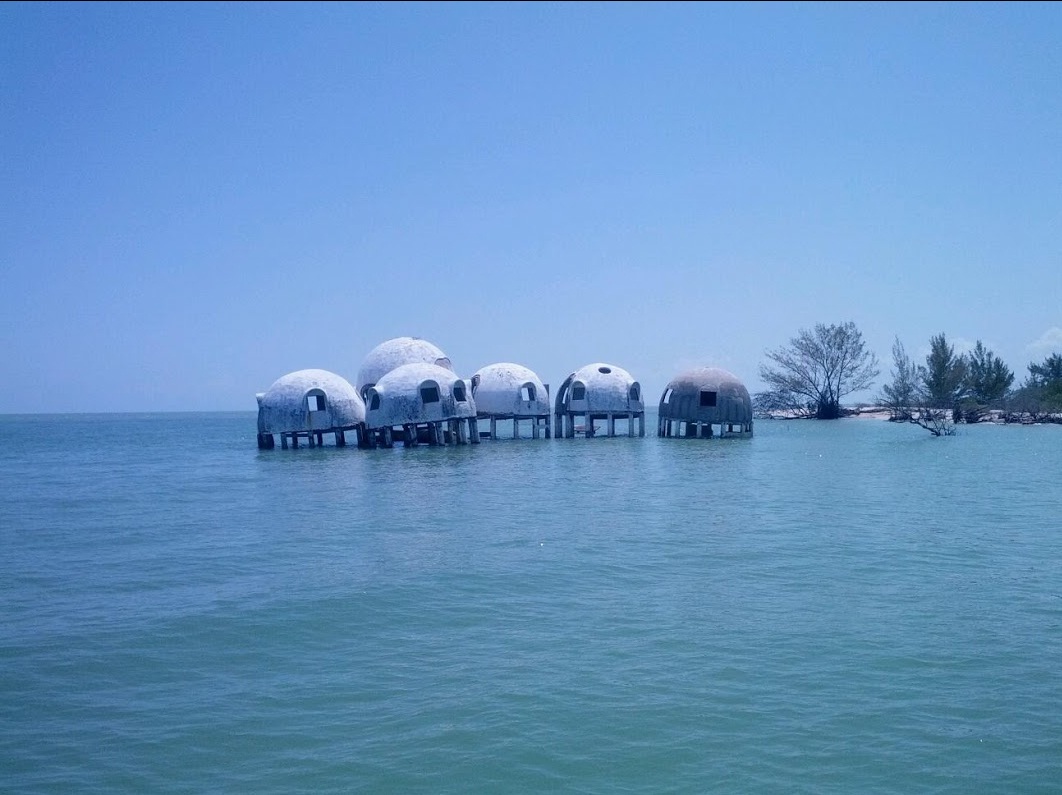
Dome Homes Under Water Now (Image credit: messynessychic.com)
When the Dome Houses were first constructed in 1980, they were situated far from the ocean on dry land on a little barrier island. A barrier island, by definition, is an island lying parallel and close to the mainland (in this case a larger island), protecting the shoreline from erosion. Barrier islands are in constant flux, changing their shape often with storms and hurricanes. They can get smaller and larger or become entirely submerged. Unfortunately, the once on dry land Dome Houses, are now immersed in the waters of the Gulf, as a result of various storms and hurricanes having continuously eroded this little barrier island.
Apparently, when the dome houses were first built, there was still so much land between them and the ocean, that it made for an exhausting walk to get to the beach!
I asked myself: how did they get the building materials for the houses out here to this remote location? After a little research it transpired that all building materials including concrete mixers and the large metal forms used as molds to make the ‘domes’, arrived by barge. Kind of obvious, there is simply no other feasible way!
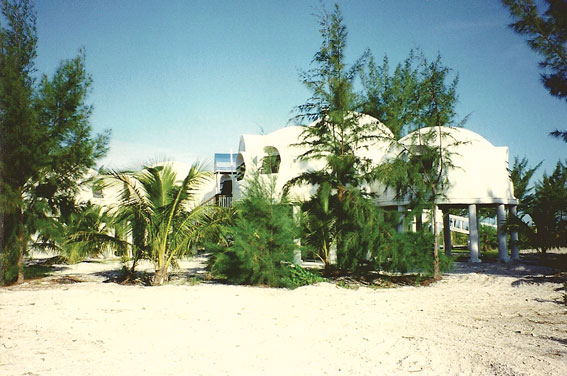
The Dome Houses On Dry Land In The 1980’s
(Image credit: www.coastalbreezenews.com)
Why Domes? The obvious answer would be: storms and Hurricanes would have a hard time doing too much damage to concrete domes, as this fairly streamlined design leaves wind with little to get its teeth into.
Perhaps an even better reason for the unusual design:
Bob Lee was an inventor and wanted to make his houses totally self-sufficient. He collected water that would run off the dome shapes into a gutter system leading through a filter to a cistern under the main dome, to use for dish-washing, showering and basically everything else but drinking.
The houses also had solar panels and a back-up generator: “The solar panels provided free electric to the 2,400 square foot home which featured air conditioning, two hot water heaters, ceiling fans, a refrigerator, a satellite dish, hot tub, gas barbecue and two lighted wooden walkways; one leading to a lagoon, the other to the ocean.”(www.coastalbreezenews.com)
Sounds pretty comfortable, luxurious even, doesn’t it? So much so that in the early 1990’s it was used as a permanent residence by some of Bob’s children and grandchildren. I felt a pang of jealousy when reading this – I would have loved to live out there: no traffic, no noise, lots of wildlife and an unspoilt beach! It must have been a magical few years for them, for sure.
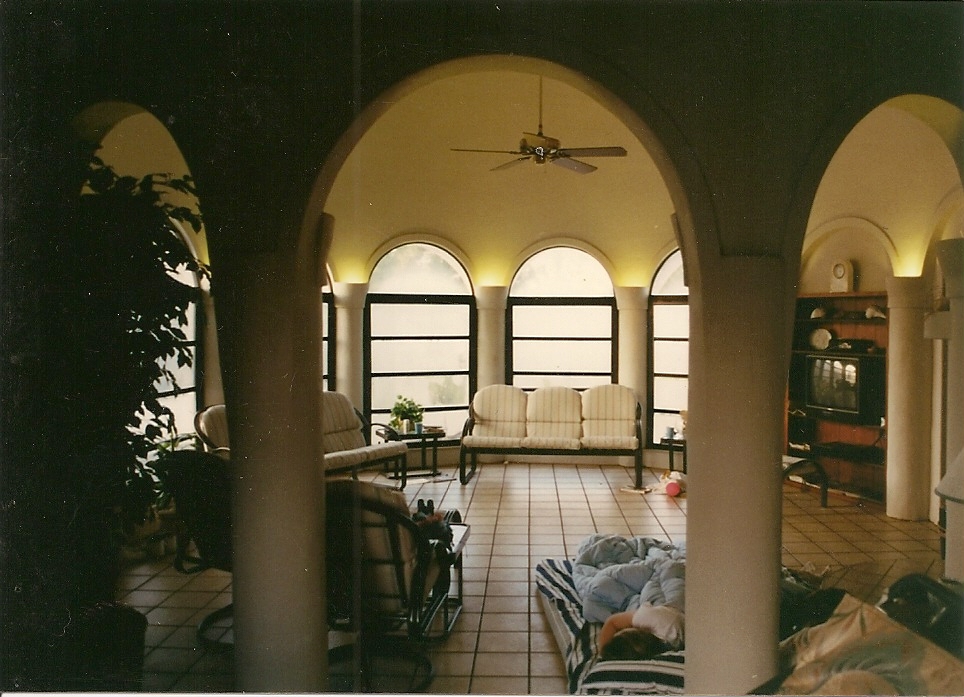
Inside Of Dome Home
(Image credit: messynessychic.com)
Some years later, after the Dome Houses had been standing empty for a while, they were purchased by a certain John Tosto in 2005. Unfortunately, he purchased the houses just before they were damaged and much land was washed away by Hurricane Wilma in October 2005. Plans to build a sea wall and renovate the houses had to be abandoned due to practicalities ( much of the land having been washed away), as well as a long standing dispute with the Collier County Code Enforcement Board.
Tosto had grand plans to relocate the domes much further away from the coastline and hoped to be able to comply with Collier County’s building codes. In the end, John Tosto’s valiant effort to preserve at least the structures of the Dome Homes for posterity, was completely hampered by regulations from various agencies:
The U.S. Army Corps of Engineers, the Department of Environmental Protection and the Collier County Code Building and Enforcement Departments. It was pretty much impossible to overcome all the rules and regulations. I actually feel bad for Tosto, as I can totally understand the wish to preserve these unique structures!
However, things were about to get a whole lot worse for the Dome Houses and Tosto in 2007, when Collier County ordered the structures to be demolished over the next two years. In November 2009 John Tosto was levied just short of $200k in fines as he had not complied with the demolition order. The outcome of this dispute is unclear at this time. Sadly, it is only a matter of time before the Dome Houses will be destroyed by the elements, even if they are not demolished by humans. The structures are crumbling and sinking into the ever-encroaching ocean. The next big storm may well be their last!
The houses and barrier islands are only accessible by boat and we had tried kayaking out there in early Nov. 2015, but unfortunately the weather decided to hamper our plans. In any case, it is a pretty long paddle (over 10 miles round trip) with patchy cell-phone service and relatively isolated. Therefore, it can only be attempted in perfect conditions and with safety equipment as well as the appropriate naval charts. Go and see them before it’s too late, I know I will, hopefully!
Tigertail Park on Marco Island
Since the conditions for us to kayak out to the Dome Houses were unfavorable, being hampered by too much wind and a choppy ocean, we had to make alternative plans and found this little gem called ‘Tigertail Park’, a small and cute Collier County Park on Marco Island.
Being a little miffed with not being able to kayak to the Dome Houses, we ended up here without having done much research and realized it was quite a bit of a walk to drag our kayaks to the beach, so be warned! However, there are kayak and paddle board rentals at Tigertail Park, so that is always an option. The Park faces out into a saltwater lagoon from which one is able to access the beach by either wading across the lagoon (squelch, squelch), or by kayaking to the little barrier island/beach on the other side of the lagoon.
At the time, it was dead low tide and the area looked like a somewhat unattractive flat mud pond. The friendly young man at the kayak rentals explained to us that it was rather shallow but should get easier as the tide was coming in. I must admit to being less than enamored with it all at this point. A couple of squelches and near flip-flop losses later, it was only going to get worse:
To add insult to injury, after a few hundred yards I was well and truly stuck in the mud in about half an inch of water, beginning to wonder what we were doing here. Luckily, after sulking and wailing much, I got help with getting pulled out and decided to hop over to the beach just on the other side of the lagoon, and wait for the tide to come up a bit higher before resuming to kayak!
Apparently, one can wade through the saltwater lagoon even at high tide and I saw people doing this. When the tide got up high, they could be seen holding their bags above their head. Not my idea of fun as the ground is squishy and with sea weed, crabs and other critters. I am certainly not a fan of walking in black muddy water with lots of unknown things potentially touching my feet! However, this can easily be solved with water shoes I suspect.
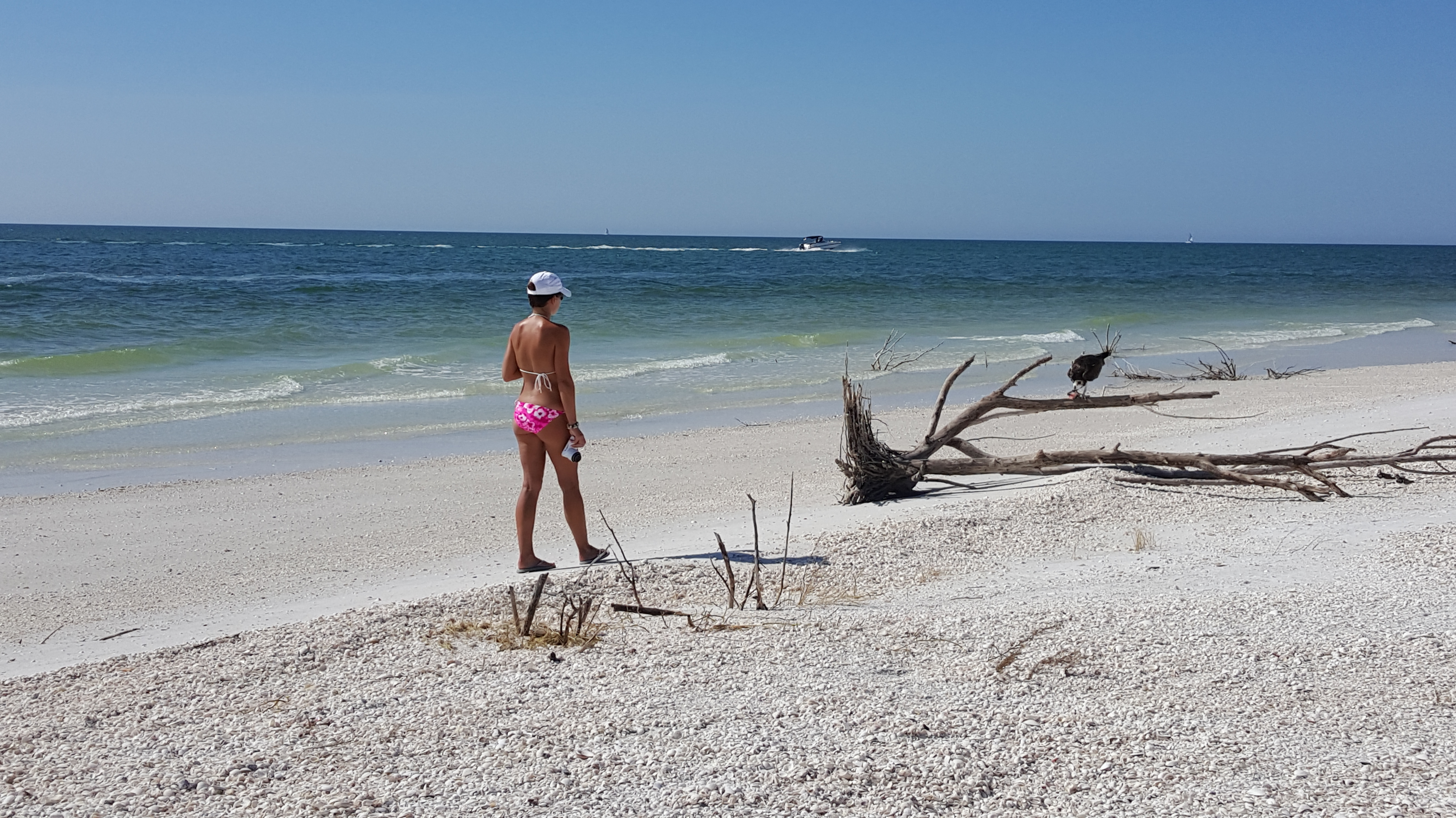 The Beach Beyond Tigertail Park Lagoon
The Beach Beyond Tigertail Park Lagoon
The beach there is absolutely beautiful, unspoilt and almost deserted! Three miles of white sands and beautiful crystal-clear water. Then it was instantly clear why it was a good idea to stop here! As if that wasn’t enough, I stumbled across a beautiful Osprey who was devouring his fresh catch of a mackerel, completely unfazed by my presence. I managed to get as close as 6 feet to this magnificent bird!
After some time at the beach, with high tide appearing, we decided to paddle further to the inlet north of Tigertail Park. There, the lagoon evidently gets much wider and deeper and so much more fun to kayak. Some large houses line the lagoon to the east and to the west are some closed off wildlife areas and lots of Ospreys! A little further along I saw boats pushed up on the sand and people enjoying some fishing and just hanging out in this beautiful spot. We decided to join them!
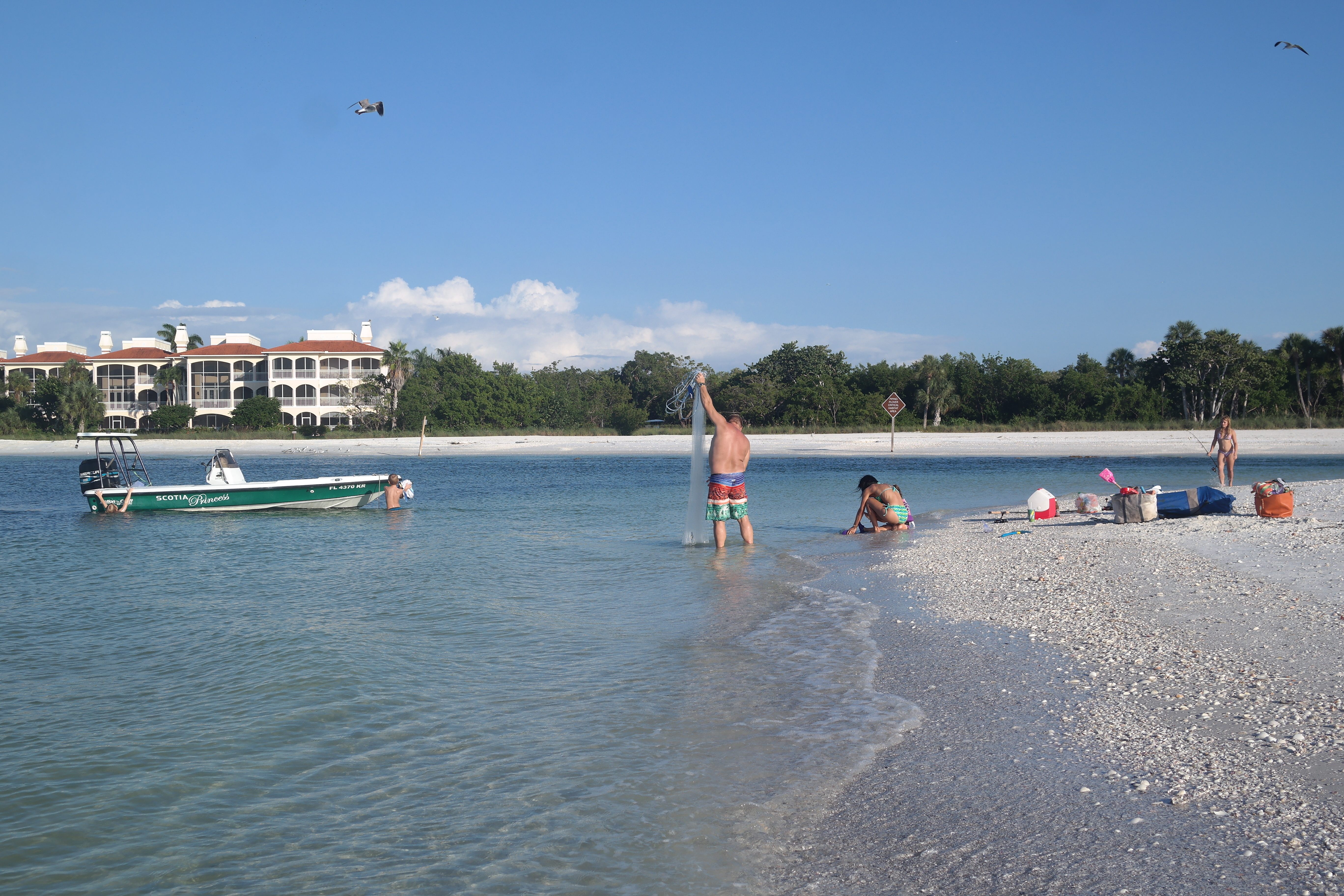 Fishing Close To The Inlet To The Lagoon
Fishing Close To The Inlet To The Lagoon
Kayaking back was a nice little exercise, as it was about 2 miles either way and we did the stretch back in one long paddle. It was already getting dark! Time flies when you’re having fun. Also, the lagoon looked so different at high tide, with lots of fish jumping and no more problems of getting stuck!
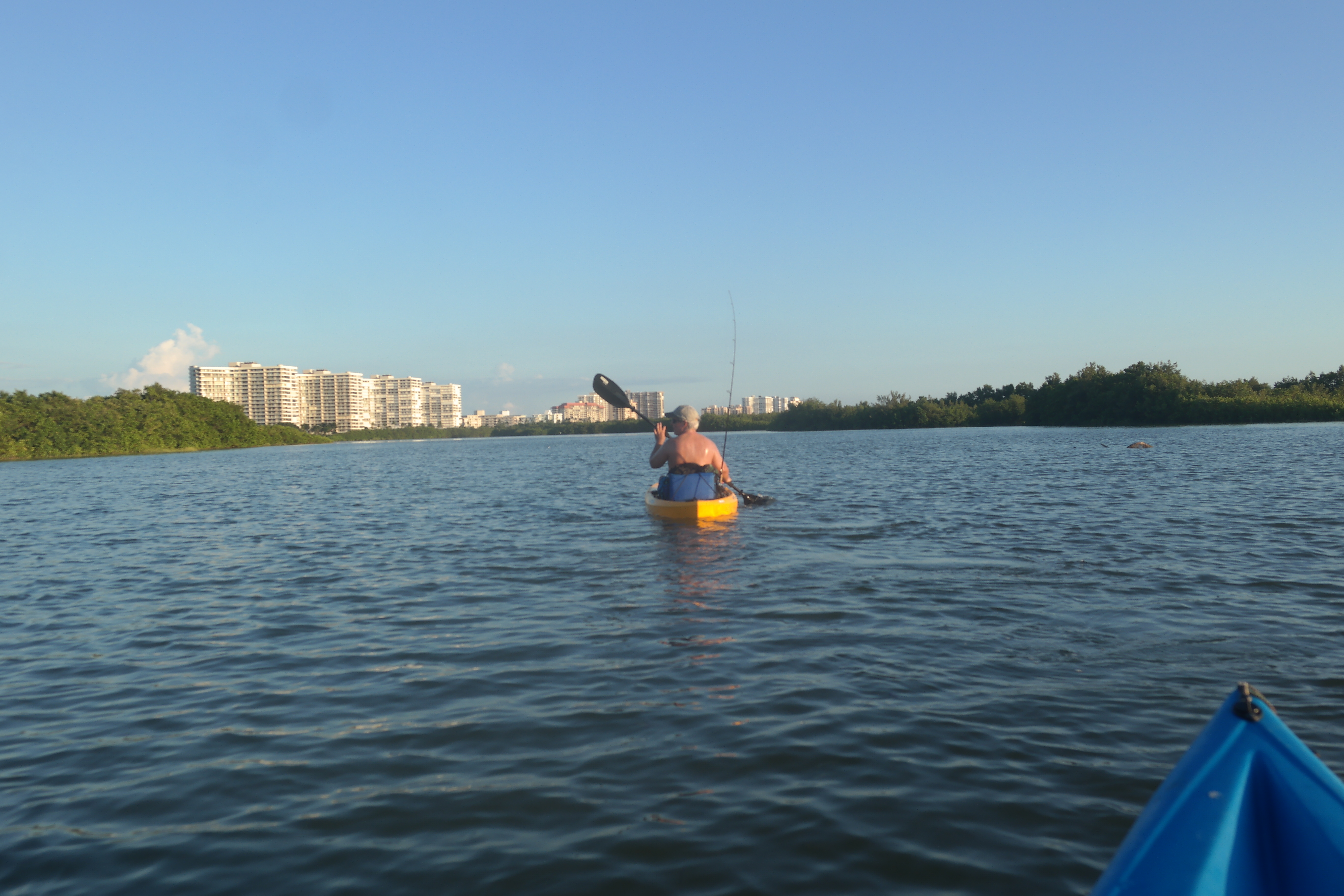
Paddling Back Towards Tigertail Park At High Tide
It was a wonderful kayaking, swimming, fishing and shelling excursion, which once again proves all is well that ends well! Even without the Dome Houses it turned out a perfect day.
Just a little word of warning, or ‘update’ on Tigertail Beach and lagoon. We came back here a second time, in July 2016, looking forward to a great paddle, which we had. However, after enjoying ourselves a little too much, fishing and hanging out at the northern tip of the barrier island opposite the park (northern end of the beach area) heading back turned into a bit of disaster and an unplanned endurance workout. Even two hours before dead low tide, the middle part of Tigertail Beach Park lagoon turned into squishy mud flats that barely had any or no water in them and what little water there was, rushed out with a vengeance. To make matters worse, a storm was brewing and looked like turning towards us. Well, let’s just say running over squishy mud/sand with kayak in tow is not my favorite activity. So the word of warning is to leave plenty of ‘tide’ and time if you want to get back in peace and without getting out and dragging your kayak.
An Excursion To Goodland
I have always maintained that in order to find a great place one has to ask the locals, and we happened to come across a lovely chap on the beach, who told us to grab dinner at the ‘Little Bar’ in Goodland, as long as we didn’t mind all the locals staring at us, because it was, apparently, a ‘real local place’. That was the key phrase, and of course we were ok with getting stared at!
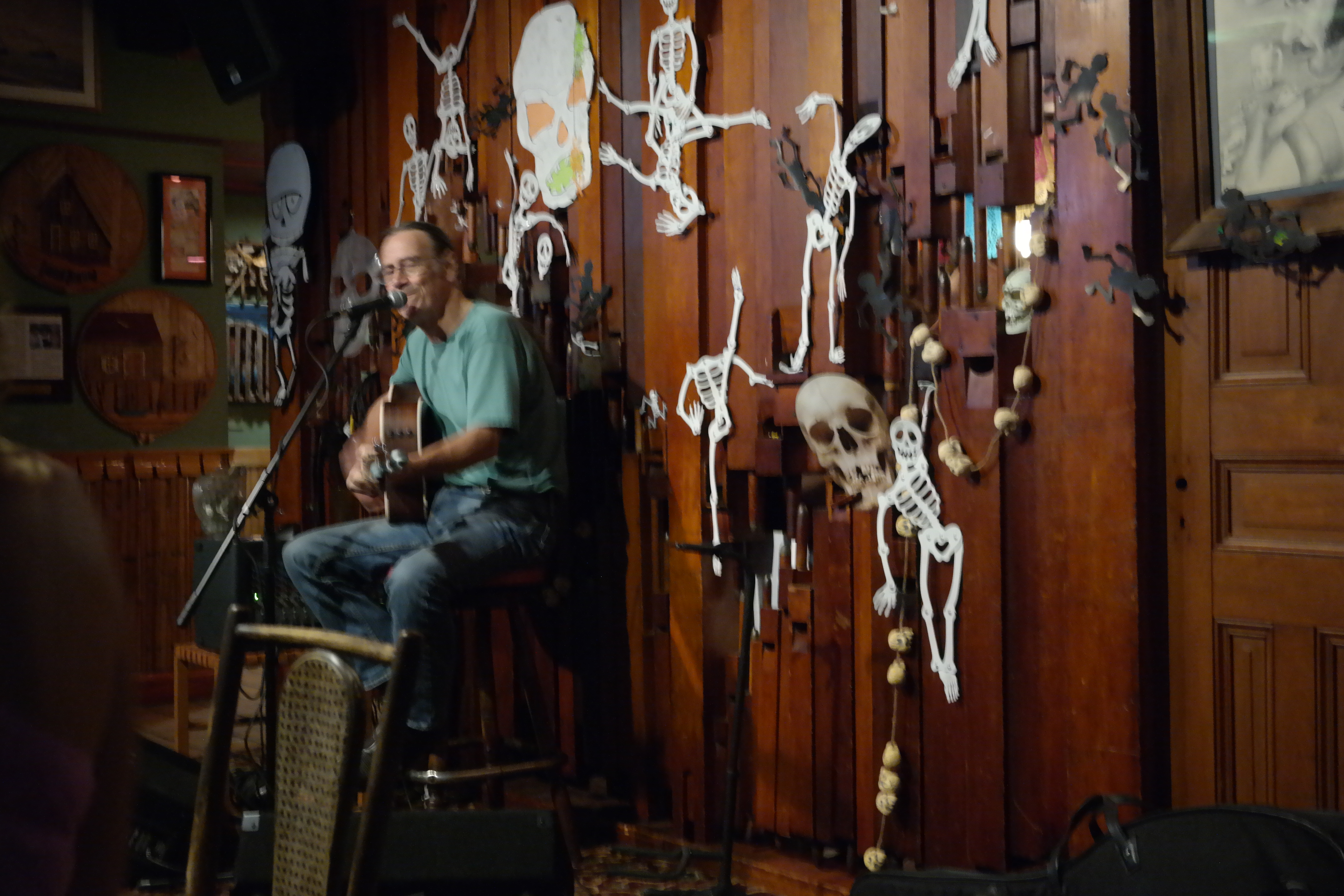 Lovely Live Music!
Lovely Live Music!
The population of Goodland was 267 at the last census in 2010 (Wikipedia.com). It’s a tiny community, consisting mostly of trailer homes. Unfortunately it was already dark when we got there. I would love to come back sometime, we had great food and much fun in the ‘Little Bar’ with live music and people playing bar games and singing along. Yes, we did get stared at but the delicious stone crabs and atmosphere were definitely worth a couple of (friendly) stares!
Have you been to the Dome Houses? Care to share any experiences, pictures, tips and hints? I would love to connect!

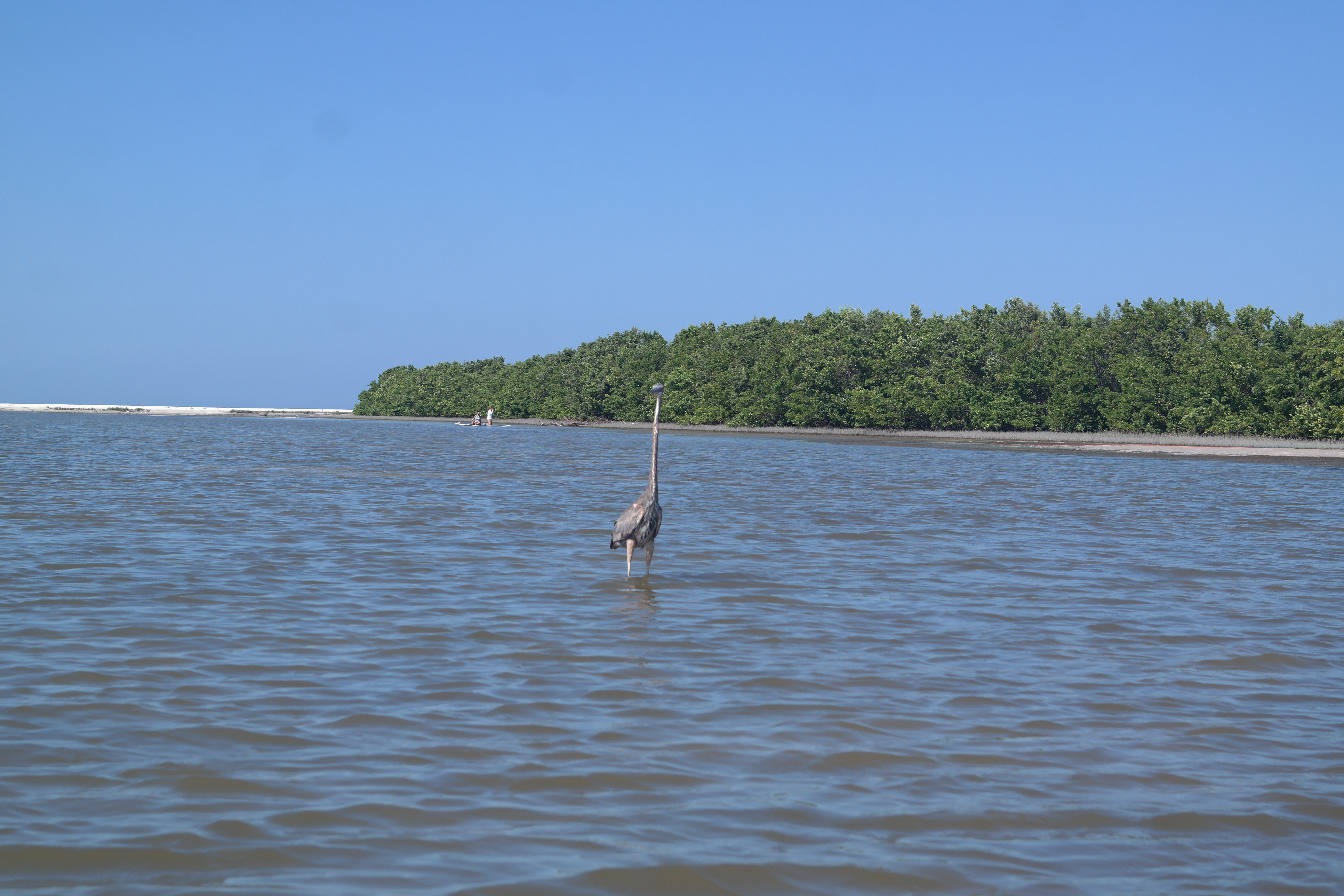
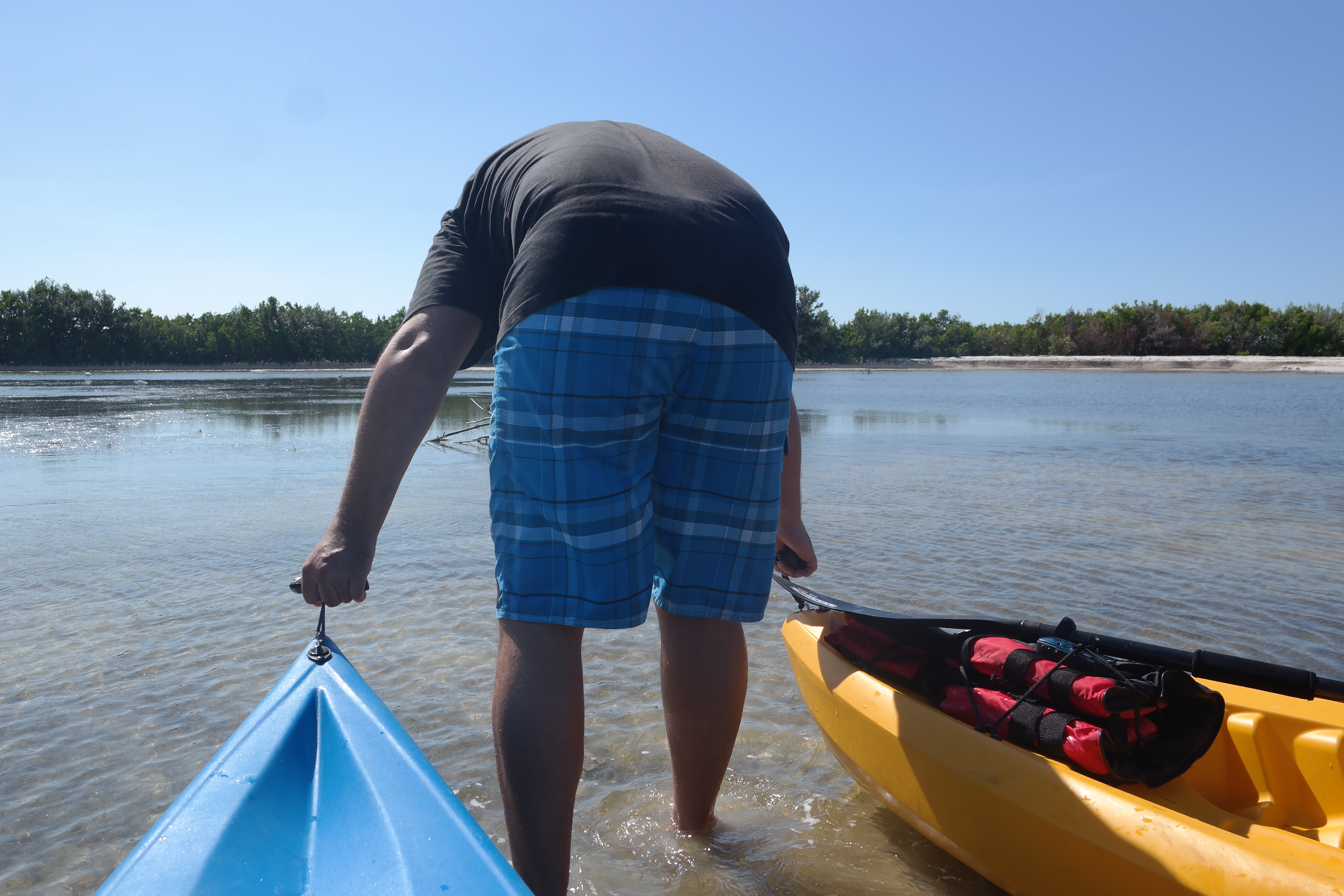
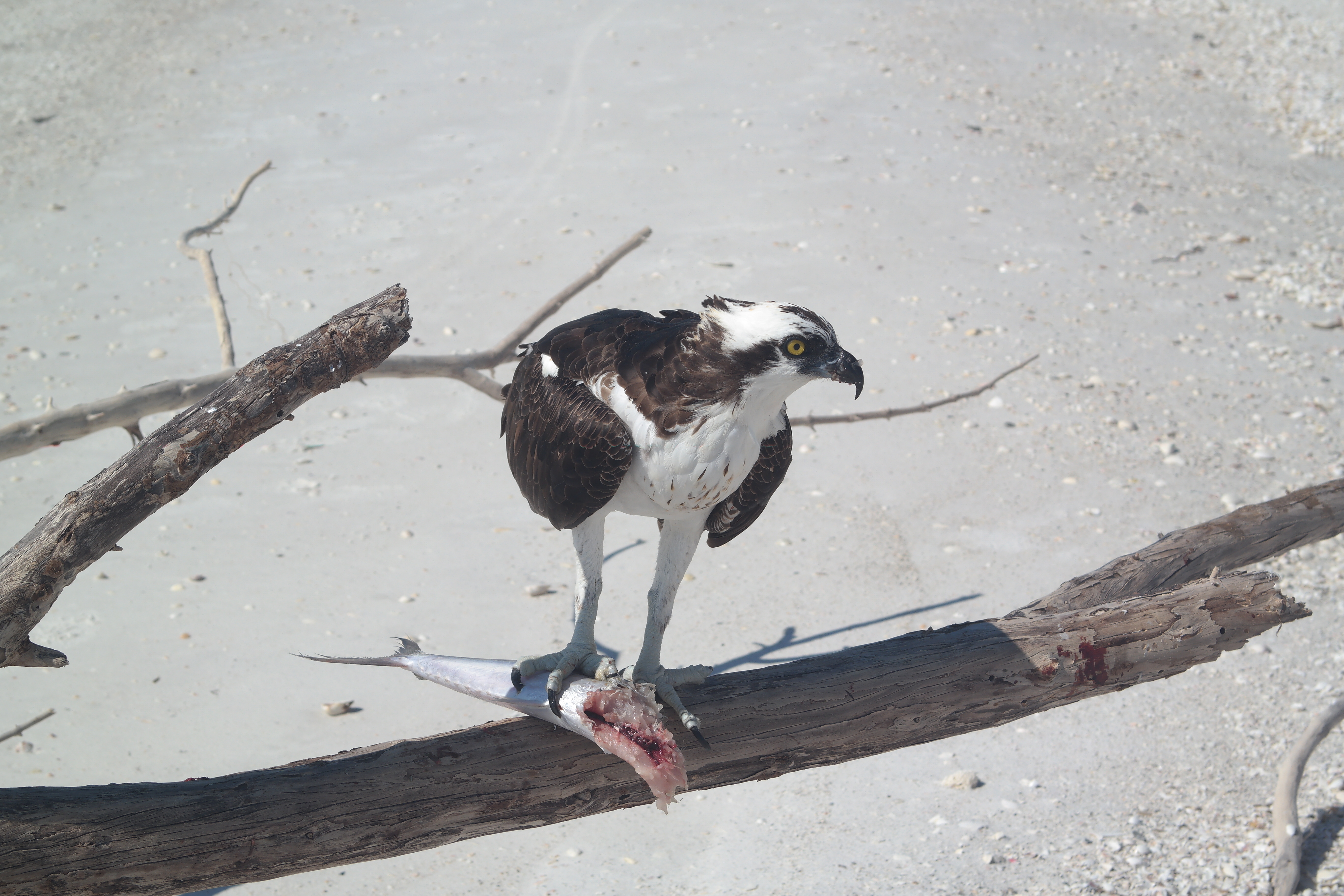
[…] The area is great for many reasons, for example you can snorkel around the Dome Homes. It is also a great spot for marine wildlife watching, fishing and enjoying the stunning and remote beaches nearby. We saw dolphins, sharks, turtles and plenty of birds in the area – unsurprisingly, with it being set within the Ten-thousand Islands area. I wrote in more detail about the Dome Homes here and here. […]